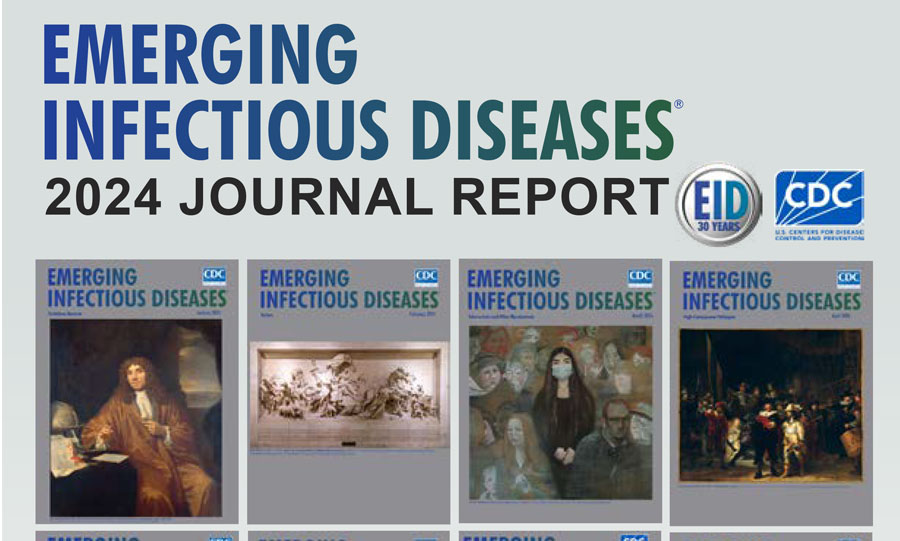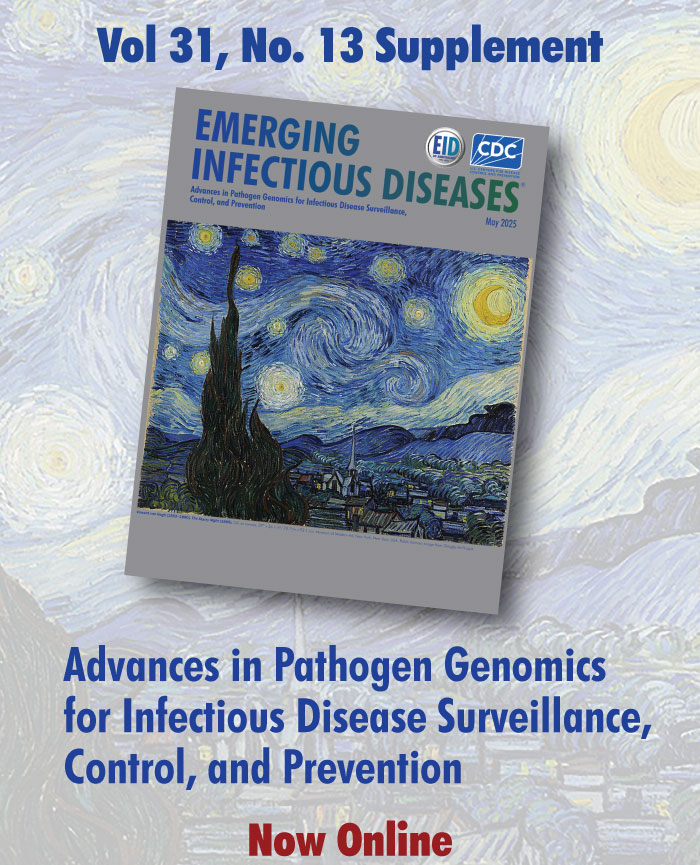Early Release
Disclaimer: Early release articles are not considered as final versions. Any changes will be reflected in the online version in the month the article is officially released.
Volume 32, Number 1—January 2026
Perspective
- Influenza D and CCoV-HuPn-2018 Emerging Respiratory Virus Threats
Synopses
-
Pulmonary Histoplasmosis, Taiwan, 1997–2024
Pulmonary histoplasmosis has traditionally been considered geographically restricted to disease-endemic regions. Taiwan, historically nonendemic, has recently witnessed rising infections. We conducted a retrospective study by reviewing adult patients in Taiwan who had pathologically confirmed pulmonary histoplasmosis during June 1997–December 2024. We analyzed 14 cases with lung involvement. Eight case-patients were male and 6 female; mean age was 56.6 years. Of note, 11 case-patients (78.6%) had no history of travel to histoplasmosis-endemic regions; 10 (71.4%) were immunocompetent. Left upper lobe involvement was most common (n = 4 [28.6%]), with nodular lesions predominating (n = 12 [85.7%]). Most (11 [78.6%]) patients received antifungal therapy, mostly with voriconazole. Outcomes were favorable; 1 (7.1%) patient died. Two additional case-patients without lung involvement exhibited similar demographics and clinical outcomes. Case identification rate has increased since 2015. This 27-year study documents the emergence of pulmonary histoplasmosis in Taiwan, emphasizing the need for heightened clinical suspicion in nonendemic regions.
- Case Series of Bacteremia Associated with Probiotic Use in Children after Cardiac Surgery
- Two Cases of Q Fever in Pregnancy, including Management of the Newborn, Australia
- Ocular Lyme Disease
Research
- Emergence of NDM-14–Producing Klebsiella pneumoniae Sequence Type 147 Clone in Spain and Outbreak in the Canary Islands
-
Reduced Emergency Department Visits and Hospitalizations in Infants after Universal Respiratory Syncytial Virus Immunization, Italy, 2024–25
During the 2024–25 winter season, a universal immunization campaign with nirsevimab was implemented in a region of Italy to prevent respiratory syncytial virus (RSV) infection among infants <12 months of age. We assessed its effects using regional syndromic surveillance data on emergency department visits (EDVs) and hospitalizations for lower respiratory tract infections and RSV infections. We estimated expected burden using an interrupted time series analysis, based on historical trends, and observed values with predictions. Children 1–5 years of age, not eligible for immunization, served as a comparison group. Among infants, EDVs for acute lower respiratory tract infections decreased by 42.7% and hospitalizations decreased by 46.5%, whereas EDVs for RSV infection decreased by 49.3% and hospitalizations decreased by 55.0%. No reductions were observed in children 1–5 years of age, confirming ongoing RSV circulation. Our findings support the effectiveness of universal nirsevimab immunization in reducing severe RSV-related outcomes among infants.
- Group A Streptococcus Meningitis, United States, 1997–2022
- Genomic Insights into Marburg Virus Strains from 2023 and 2025 Outbreaks in Kagera, Tanzania
- Effect of Chloramine Disinfection of Community Water System on Legionnaires’ Disease Outbreak, Minnesota, United States
- Enhanced isolation and detection of SARS-CoV-2 in hospitalized patients undergoing antiviral therapy
- Lymphocytic Choriomeningitis Virus Seroprevalence among Urban Pregnant Women and Newborn Infants, Philadelphia, USA, 2021
- Detection of Novel Thermotolerant Tepidimonas Species Bacteria in Human Respiratory Specimens, Hong Kong, China, 2024
- Clinical features of infections caused by newly emerging Trichosporon species
Dispatches
- Identification of Sphingobacterium hotanense Infections, North America, 2020–2025
- Dermacentor occidentalis Ticks Linked to Rickettsia lanei Infections, California, USA
- Evidence of rat hepatitis E virus circulation through wastewater surveillance in central Argentina
- Detection of H5-Specific Antibodies by Two Chemiluminescent Assays
- Disseminated Nocardia ignorata Infection with Splenic and Brain Involvement in Patient with Large B Cell Lymphoma
- Presence or Emergence of Canine Leishmaniasis, Malawi
- Enhanced Surveillance Reveals Cases of Oropouche and Punta Toro Viruses, Panama, 2023–2024
Research Letters
- Mycobacterium decipiens Infection in Patient Treated with Anti-TNFα Therapy, France, 2024
- Donor Screening Failure for Strongyloides stercoralis in Solid Organ Transplantation
- Serologic Evidence of Exposure to Burkholderia pseudomallei, Nigeria
- Molecular Analysis of Emerging MT27 Macrolide-Resistance Bordetella pertussis, Kobe, Japan, 2025
- Serologic Investigation of Influenza D Virus in Cats and Dogs, Europe
- Fatal Ehrlichia muris eauclairensis Infection in Liver Transplant Recipient, Minnesota, USA
Online Report
- Integrating Prevention and Response at the Crossroads of Henipavirus Preparedness, Hendra@30 Conference, 2024
Volume 32, Number 2—February 2026
Letter
- Candida auris Testing by the Antimicrobial Resistance Laboratory Network, United States, 2022–2023
Winter Supplement
- Postinfectious Syndromes and Long-Term Sequelae after Giardia Infections
- Functional Limitations and Illness-Related Absenteeism among School-Aged Children Experiencing Long COVID, United States, 2022–2023
-
Nonspecific Symptoms Attributable to Lyme Disease in High-Incidence Areas, United States, 2017–2021
For some patients who have Lyme disease (LD), nonspecific symptoms can persist after treatment and impair quality of life. Estimating the frequency and duration of such symptoms is challenging. Using commercial insurance claims data from 2017–2021 for enrollees residing in states where LD is common, we identified 24,503 case-patients with LD and matched them (1:5) with 122,095 control-patients with other diagnoses by demographics, medical service date, and inpatient/outpatient setting. We compared relative frequencies of diagnosis codes for pain, fatigue, and cognitive difficulties between case-patients and control-patients in the year after diagnosis. Those symptom codes occurred 5.0% more frequently among case-patients than among control-patients and comprised »11.0% of the total symptom codes among case-patients. Symptom code frequency among case-patients declined significantly in the 6–12 months after LD diagnosis and reached levels similar to control-patients by the end of the year, with the exception of fatigue.
- Progress Toward Understanding Infection-Associated Chronic Conditions and Illnesses
-
Persistence of Symptoms among Commercially Insured Patients with Coccidioidomycosis, United States, 2017–2023
Some patients with coccidioidomycosis experience prolonged respiratory and systemic symptoms. However, data on prevalence and persistence of most symptoms are lacking. Using an insurance claims database, we identified patients with coccidioidomycosis diagnoses in the United States during 2017–2023. We assessed prevalence of associated symptoms from 6 months before to 1 year after first diagnosis code (index date) and compared post–index date prevalence to baseline (within 6 to 4 months before index date). Among 2,640 patients, cough (20.8%), dyspnea (13.0%), and fatigue (8.8%) were the most common symptoms at index date. Dyspnea and erythema nodosum were elevated 3–6 months post–index date (p<0.03), and fatigue, headache, joint pain, and weakness were elevated 9–12 months post–index date compared with baseline (p<0.05).These findings demonstrate that symptoms can persist in coccidioidomycosis patients, which could help inform clinical management and refine estimates of the health and economic burden of coccidioidomycosis.
-
Long-Term Illness in Adults Hospitalized for Respiratory Syncytial Virus Disease, United States, February 2022–September 2023
Respiratory syncytial virus (RSV) can cause severe illness, but little is known about long-term consequences in hospitalized adults. We surveyed adults (>18 years of age) who survived hospitalization for RSV or COVID-19 during February 2022–September 2023 about physical functioning and quality of life; surveys were conducted 6–12 months after hospitalization. We compared outcomes after RSV hospitalization by age (<60 vs. >60 years) and to those hospitalized for COVID-19 by using multivariable regression models. Among 146 adults hospitalized with RSV, 27.4% reported severe breathlessness and 21.9% poor quality of life at follow-up. Few differences were seen in posthospital illness by age. After adjustment, participants with RSV had 1.81 (95% CI 1.08–3.04) times increased odds of worse dyspnea than did those with COVID-19. Participants reported functional and quality of life impairments after RSV hospitalization, regardless of age, and a postdischarge sequelae constellation similar to that for those hospitalized for COVID-19.
- Thrombotic Events and Stroke in the Year After SARS-CoV-2 or Other Acute Respiratory Infection




